In this guide, we’ll explore deep into what is progressive web app development, how it works, examples, and why they are transforming offshore web development
What is Progressive Web App Development
Let’s start with the basics. What does PWA stand for, and what does pwa meaning?
In other words, it offers the responsiveness and reach of a website with the immersive, interactive experience of a mobile app.
What is PWA Technology
PWA technology focuses on creating a fast, reliable, and engaging user experience across all devices.
It loads quickly, even in poor network conditions, and offers functionalities such as push notifications and offline access.
PWAs are built using standard web technologies like HTML, CSS, and JavaScript, making them highly adaptable and easy to develop with low-cost
The Key Features of PWA Definition
So, what makes PWAs stand out? Let’s explore the key features that set them apart from traditional web apps which cost higher.
1. Progressive
what does pwa mean? The name says it all.
PWAs are designed to work for every user, regardless of their device or browser. They progressively enhance their capabilities as more features become available.
2. Responsive
PWAs adapt to different screen sizes and orientations, ensuring a consistent device experience.
3. Connectivity Independent
One of the most remarkable aspects of PWAs is their ability to function offline or with a poor network connection.
This is achieved through the use of service workers, which cache essential resources for offline access.
4. App-Like Experience
PWAs offer a user interface and experience similar to native mobile apps, including smooth animations, gestures, and a full-screen view.
5. Discoverability
PWAs can be found and indexed by search engines just like regular websites, making them easily discoverable.
6. Re-manageability
PWAs can send push notifications to users, keeping them engaged and informed about updates and offers.
7. Installability
This makes them convenient to access and keeps them top-of-mind for users.
8. Linkable and Shareable
PWAs are linkable and shareable just like websites, allowing easy distribution through URLs.
What is Progressive Web App Development Example
Now that we’ve covered the basics, you might be wondering how PWAs are used in the real world. Let’s take a look at some examples:
Twitter Lite
Twitter’s PWA offers a fast and data-efficient version of the platform. It reduces data usage and loads quickly, making it ideal for users in regions with limited connectivity.
AliExpress
The popular e-commerce platform uses a PWA to offer an app-like shopping experience on the web. It boosts user engagement and provides an exceptional shopping journey.
Starbucks
Starbucks’ PWA allows users to browse the menu, customize orders, and add items to their cart, even when offline.
Once back online, they can complete their purchase.
These examples show how PWAs can enhance user experience, increase engagement, and boost conversions for businesses.
What are the Benefits of Developing a Progressive Web App Development
Why should you consider investing in PWA development for your business? Here are some benefits:
Cost-Effective
Building a PWA can be more cost-effective than developing separate native apps for Android and iOS.
Wide Reach
PWAs are accessible to users across all devices and platforms, increasing your audience reach.
Improved User Engagement
Features like push notifications and offline access keep users engaged and coming back for more.
High Performance
PWAs load quickly and provide a smooth, app-like experience, even in challenging network conditions.
SEO-Friendly
Since PWAs are discoverable by search engines, they can help improve your website’s search engine rankings.
Easy Updates
Unlike native apps, PWAs update automatically, ensuring users always have the latest version.
Developing a PWA: Key Considerations
Building a Progressive Web App (PWA) can enhance performance of your website.
Here’s a step-by-step guide on how to build a PWA
Understand PWA Basics
Start by familiarizing yourself with the core concepts of PWAs.
A PWA combines the best aspects of websites and mobile apps, offering app-like experiences on the web.
PWAs work across all devices, are discoverable by search engines, and can function offline.
Choose the Right Framework
Various frameworks are available for PWA development, such as React, Angular, and Vue.js. Choose one that best suits your project’s requirements.
Setup Your Development Environment
Choose your preferred development framework such as React, Angular, or Vue.js. Set up your development environment accordingly, and install the tools and libraries for your project.
Create a Web App Manifest
The web app manifest is a JSON file that provides important information about your app, such as its name, icons, and colors.
It allows users to install your PWA on their devices. Save the manifest file in your project and link to it in your HTML file.
Focus on Performance
Optimize your PWA for speed and efficiency. This includes minimizing server requests, compressing images, and leveraging browser caching.
Create a Service Worker
A service worker is essential for enabling offline functionality and other advanced features. Make sure to implement one effectively.
Design a Responsive UI
Design a user interface that adapts to different screen sizes and orientations.
Use responsive design principles, such as flexible grids and media queries, to ensure your PWA provides a consistent experience across devices.
Add PWA Features
Incorporate key features such as push notifications, offline access, and app-like navigation.
Utilize JavaScript APIs to access device capabilities and provide immersive experiences.
Test Across Devices
Ensure your PWA performs well on different devices and browsers to provide a consistent user experience.
Prioritize User Experience
Keep your users’ needs in mind when designing your PWA.
What is progressive web app development – Conclusion
Ready to take the leap into the world of PWAs? Whether you’re a business owner looking to expand your online presence or a developer seeking new opportunities, now is the time to explore the potential of progressive web apps.
What does PWA stand for?
PWA stands for Progressive Web App, a web application that offers app-like experiences on the web.
How does a PWA work offline?
PWAs use service workers to cache essential resources, allowing users to access the app and its content even without an internet connection.
Are PWAs compatible with all devices?
Yes, PWAs are designed to work on any device and platform, including desktops, tablets, and smartphones.
How can a PWA improve my business?
A PWA can enhance user engagement, increase conversions, and expand your reach by offering a smooth and reliable experience to all users.
What are the key benefits of developing a PWA?
Key benefits include cost savings, improved performance, wider reach, and enhanced user engagement due to app-like features and functionalities.







